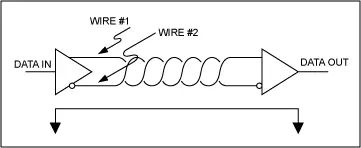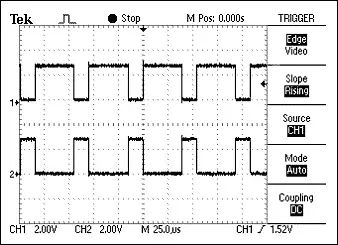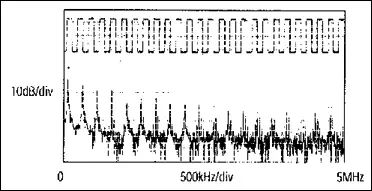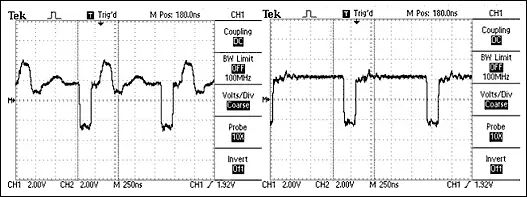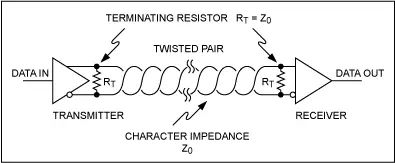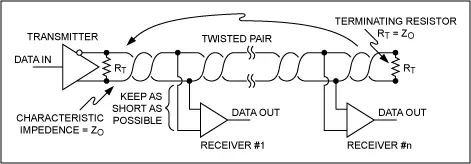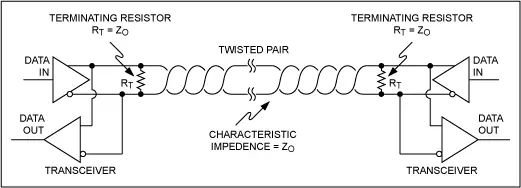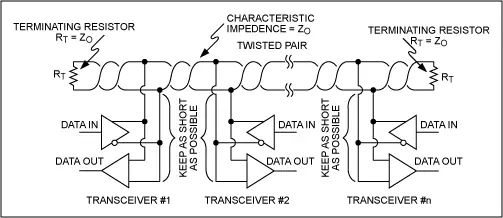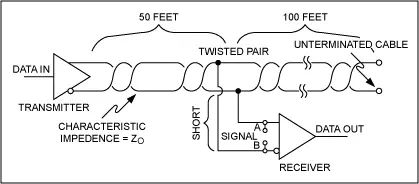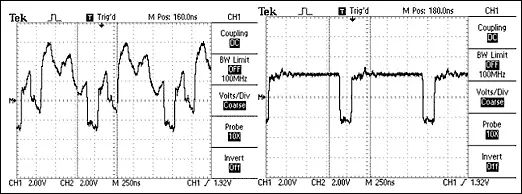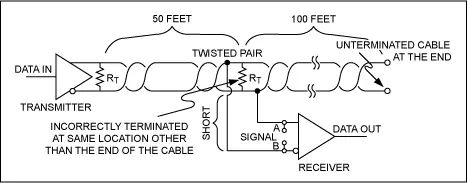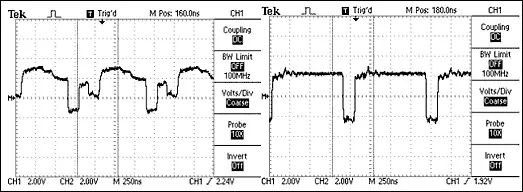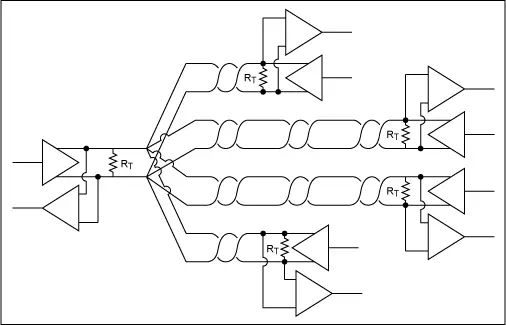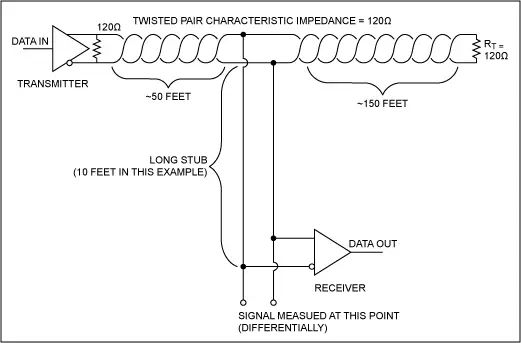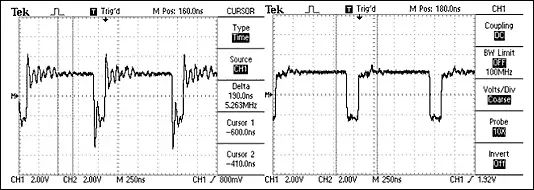Abstract
This article introduces the correct connection methods for RS-485 networks, including twisted pair wiring and recommendations for proper installation of termination resistors. It lists the receiver waveforms under correct and incorrect termination.
This application note provides a basic guide for connecting RS-485 networks. The RS-485 specification (officially known as TIA/EIA-485-A) does not specifically dictate how to connect RS-485 networks. Nevertheless, the specification does provide some guidelines. These guidelines and good engineering practices form the basis of this application note. However, the recommendations presented in this article do not cover all the different ways to design a network.
RS-485 transmits digital information between multiple locations. Data rates can reach up to 10 Mbps, and sometimes even higher. RS-485 designs are primarily used for transmitting information over long distances, with capabilities fully meeting distances of 1000 meters. The successful transmission distance and data rate of RS-485 largely depend on the wiring method of the system.
Wiring The design of RS-485 is for a balanced system. Simply put, it uses two wires to transmit signals without a ground.
Figure 1. A balanced system transmits data using two wires without a ground.
The system is called balanced because ideally, the signal on one wire is strictly opposite to the signal on the other wire. In other words, if one wire sends a high level, the other wire will send a low level, and vice versa, as shown in Figure 2.
Figure 2. The signals on the two wires in a balanced system are strictly opposite.
Although RS-485 can successfully transmit using various types of media, it is recommended to use the wiring method commonly referred to as “twisted pair.”
What is Twisted Pair? Why Use Twisted Pair? As the name suggests, twisted pair consists of a pair of equal-length wires twisted together. RS-485 compatible transmitters used with twisted pair help reduce the two main sources of failure in designing high-speed long-distance networks: radiated EMI and received EMI.
Radiated EMI As shown in Figure 3, high-frequency components are generated when information is sent using fast-changing edges. Since RS-485 can transmit at high data rates, fast-changing edges are essential.
Figure 3. 125kHz square wave and its FFT plot.
The inevitable high-frequency components in fast-changing edges couple with long connecting wires, producing radiated EMI. The balanced system using twisted pair makes the system an inefficient radiator, reducing this effect. The principle is simple: since the signals on the transmission lines are equal and opposite in polarity, the signals radiated from each wire are also equal and opposite in polarity. This creates a canceling effect, meaning there is no net radiated EMI. However, this result is based on one premise: the lengths of the connecting wires are strictly equal and their positions are strictly the same. Since the two wires cannot be in the same position simultaneously, they should be kept as close to each other as possible. Twisting the two wires together keeps the distance between them very limited, helping to cancel out the residual EMI.
Received EMI Received EMI is essentially the same problem as radiated EMI, but in the opposite direction. The cables used in RS-485 systems also act as antennas receiving harmful signals. These harmful signals can distort useful signals and, if severe enough, cause data errors. For the same reasons that twisted pair helps prevent radiated EMI, it also helps reduce the impact of received EMI. Because the two wires are close together and twisted, the noise received on one wire will tend to be the same as the noise received on the other wire. This type of noise is referred to as “common-mode noise.” Since RS-485 receivers are designed to detect signals that are opposite in polarity, they can easily suppress common-mode noise.
Characteristic Impedance of Twisted Pair The “characteristic impedance” of twisted pair is generally provided by the manufacturer, depending on the cable’s geometry and the insulation materials used. The RS-485 specification recommends but does not specifically mandate that the characteristic impedance should be 120Ω. This impedance is recommended as it is necessary for calculating the worst-case operating conditions load and common-mode voltage range in the RS-485 specification. The specification does not specifically mandate this impedance, possibly for flexibility reasons. If for some reason a 120Ω cable cannot be used, it is recommended to recalculate the worst-case operating conditions load (the number of transmitters and receivers that can be used) and the worst-case common-mode voltage range to ensure that the designed system can operate correctly. The industry standard TSB89 “ATIA-EIA-485-A Application Guide” has a chapter dedicated to these calculations.
Number of Twisted Pair per Transmitter After understanding the required type of transmission line, the reader may ask: How many pairs of twisted pairs can a transmitter drive? The simple answer is: only one pair. Although a transmitter may be able to drive multiple twisted pairs under specific environmental conditions, this does not comply with the specification.
Termination Resistors Due to the involvement of high frequencies and distances, careful attention must be paid to transmission line effects. However, a detailed discussion of transmission line effects and proper termination techniques is beyond the scope of this application note. Therefore, this article briefly discusses the simplest form of termination resistors related to RS-485.
Termination resistors are resistors installed at the end of the cable (Figure 4). The value of the termination resistor ideally matches the characteristic impedance of the cable.
Figure 4. The termination resistor value should match the characteristic impedance of the twisted pair and should be installed at the far end of the cable.
If the termination resistor value differs from the characteristic resistance of the connecting wire, reflections will occur as the signal travels through the cable. This process is given by the formula (Rt – Zo)/(Zo + Rt), where Zo is the cable impedance and Rt is the termination resistor value. Although cable and resistor tolerances will cause some unavoidable reflections, a sufficiently large mismatch will cause larger reflections that can lead to data errors, as shown in Figure 5.
Figure 5. Using the circuit shown above, the waveform on the left is obtained through MAX3485 driving a 120Ω twisted pair cable with a termination resistor of 54Ω; the waveform on the right is obtained with a correctly terminated cable using a 120Ω resistor.
After understanding reflections, it is crucial to match the termination resistor as closely as possible to the characteristic impedance. The position of the termination resistor is also very important. The termination resistor should be installed at the far end of the cable.
Additionally, as a general rule, termination resistors should be installed at both ends of the cable. Although it is critical for most system designs to correctly install termination resistors at both ends, it can be said that in some special cases, only one termination resistor is needed. When there is only a single transmitter in the system, and the transmitter is located at the far end of the cable, in this case, since the signal is always sent from the end of the cable where the transmitter is located, there is no need to install a termination resistor at that end.
Maximum Number of Transmitters and Receivers on the Network The simplest RS-485 network consists of one transmitter and one receiver. Although this configuration is useful in many applications, RS-485 allows multiple receivers and transmitters to be connected on a pair of twisted pairs, providing greater flexibility. The maximum number of transmitters and receivers allowed depends on the load formed by each device on the system. Ideally, the impedance of all receivers and stopped transmitters should be infinite, so as not to overload the system. However, this is not the case in practical applications. Each receiver connected to the network and all stopped transmitters will increase the load.
To help designers of RS-485 networks determine how many devices can be added to the system, a hypothetical unit called “unit load” is created. All devices connected to the RS-485 network should be characterized as multiples or fractions of unit load. Two examples are MAX3485 (characterized as 1 unit load) and MAX487 (characterized as 1/4 unit load). Assuming the characteristic impedance of the cable is 120Ω and correctly terminated, the maximum number of unit loads allowed on a pair of twisted pairs is 32. In this example, this means that a maximum of 32 MAX3485 or up to 128 MAX487 can be connected on a single network.
Fail-Safe Bias Resistors When the input is between -200mV and +200mV, the receiver output is “undefined.” There are four common fault conditions that can cause the receiver output to be undefined, leading to data errors:
All transmitters in the system are turned off
The receiver is not connected to the cable
The cable is open
The cable is shorted
Using fail-safe bias ensures that the receiver output is in a defined state when any of the above conditions occur. Fail-safe bias includes pull-up resistors on the non-inverting line and pull-down resistors on the inverting line. When biased correctly, if any fault condition occurs, the receiver will output a valid high level. These fail-safe bias resistors should be installed at the receiver end of the transmission line.
Maxim’s MAX13080 and MAX3535 families of transceivers do not require fail-safe bias resistors because the devices already integrate true fail-safe functionality. In true fail-safe functionality, the receiver threshold range is -50mV to -200mV, so fail-safe bias resistors are not needed while fully complying with the RS-485 standard. These devices ensure that the receiver input produces a logic “high” output when the line is at 0V. Furthermore, this design guarantees that the receiver output state is defined under open or shorted line conditions.
Correct Network Examples After understanding the above information, we can design some RS-485 networks. Here are a few examples.
One Transmitter, One Receiver The simplest network consists of one transmitter and one receiver (Figure 6). In this example, the termination resistor is located at the transmitter end of the cable. Although it is not necessary in this example, designing two termination resistors is a good practice. This allows the transmitter to be moved to other locations beyond the far end and allows for the addition of more transmitters to the network when necessary.
Figure 6. An RS-485 network with one transmitter and one receiver.
One Transmitter, Multiple Receivers Figure 7 shows a network with one transmitter and multiple receivers. In this example, it is very necessary to keep the distance of the twisted pair to the receivers as short as possible.
Figure 7. An RS-485 network with one transmitter and multiple receivers.
Two Transceivers Figure 8 shows a network with two transceivers.
Figure 8. An RS-485 network with two transceivers.
Multiple Transceivers Figure 9 shows a network with multiple transceivers. As with the one transmitter and multiple receivers network shown in Figure 7, it is very necessary to keep the distance of the twisted pair to the receivers as short as possible.
Figure 9. An RS-485 network with multiple transceivers.
Incorrect Network Examples Below are examples of incorrectly configured systems. Each example provides waveforms obtained from incorrectly designed networks compared to waveforms from correct systems. The waveforms are measured differentially (A-B) from points A and B.
Unterminated Network In this example, the termination resistor is not installed at the end of the twisted pair. When the signal travels along the connecting wire, it encounters an open circuit at the end of the cable. This creates an impedance mismatch, resulting in emissions. In the open circuit case (as shown below), all energy is reflected back to the source end, causing severe distortion of the waveform.
Figure 10. An unterminated RS-485 network (top) and the resulting waveform (left), compared to the waveform obtained from a correctly terminated network (right).
Incorrect Termination Location In Figure 11, the termination resistor is installed, but it is not placed at the far end of the cable. When the signal travels along the connecting wire, it encounters two impedance mismatches. The first occurs at the termination resistor. Even if the resistor matches the characteristic impedance of the cable, there is still cable after the resistor. The subsequent cable causes an impedance mismatch, leading to reflections. The second mismatch occurs at the end of the unterminated cable, causing further reflections.
Figure 11. An RS-485 network with incorrect termination location (top) and the resulting waveform (left), compared to the waveform obtained from a correctly terminated network (right).
Multiple Cables The layout shown in Figure 12 has multiple issues. RS-485 drivers are designed to drive a single pair of correctly terminated twisted pairs. In this example, the transmitter drives four pairs of parallel twisted pairs. This means that the required minimum logic level cannot be guaranteed. In addition to the large load, the connection points of multiple cables present impedance mismatches. Impedance mismatches mean reflections, leading to signal distortion.
Figure 12. An RS-485 network incorrectly using multiple pairs of twisted pairs.
Long Branches In Figure 13, the cable is correctly terminated, and the transmitter drives only one pair of twisted pairs. However, the connection point (branch) of the receiver is too long. Long branches create significant impedance mismatches, leading to reflections. All branches should be kept as short as possible.
Figure 13. An RS-485 network with a branch length of 10 feet (top) and the resulting waveform (left), compared to the waveform obtained from a short branch (right).
References TSB89, TIA/EIA-485-A Application Guide, can be found at the following website: www.global.ihs.com. For more information, please refer to the electrical characteristics of generators and receivers in TIA/EIA-485-A balanced digital multipoint systems, available at: www.global.ihs.com.
